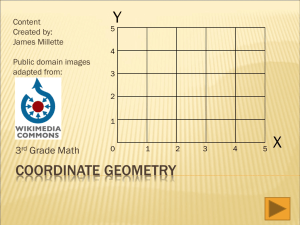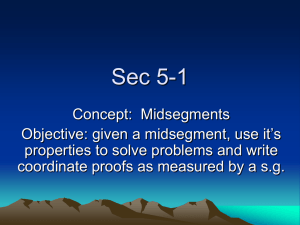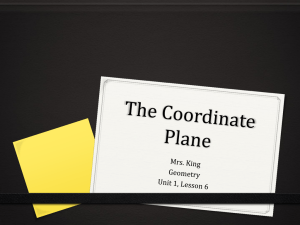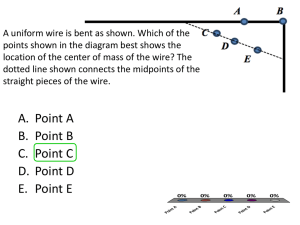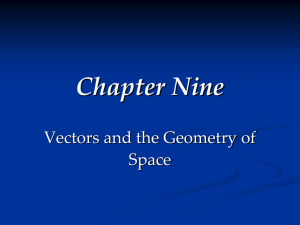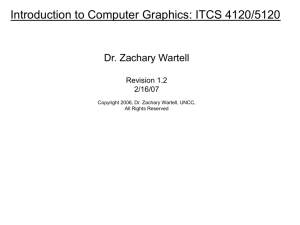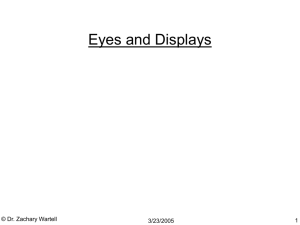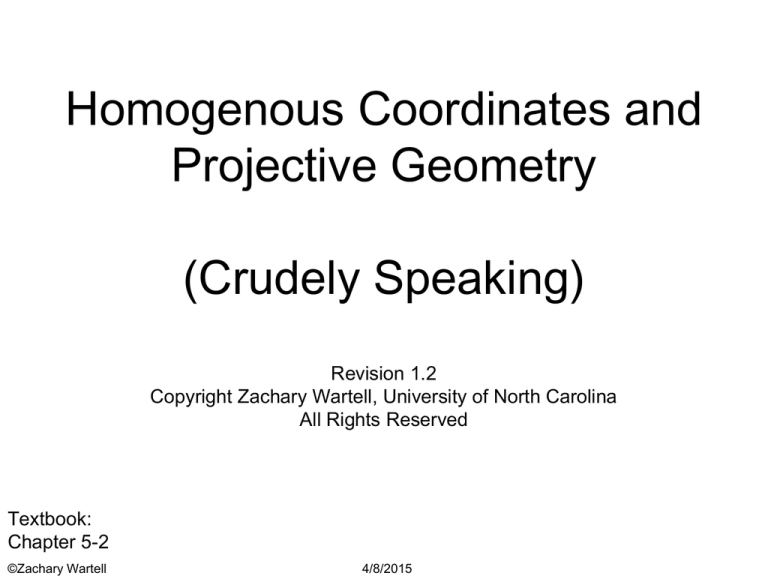
Homogenous Coordinates and
Projective Geometry
(Crudely Speaking)
Revision 1.2
Copyright Zachary Wartell, University of North Carolina
All Rights Reserved
Textbook:
Chapter 5-2
©Zachary Wartell
4/8/2015
Review
•
points, vectors, alignments:
ITCS 4120-2D Coordinates.ppt Slide #13
•
vector – all arrows of same length and direction are associated with same
vector, v, designated by coordinate (x,y,z) or column matrix [x,y,z,0]T
•
alignment – For any line, l , there exists an infinite set, S, of all lines parallel
to l . Let’s give a coordinate (i.e. a name) to, S, using the slopes of l .
Ideas?
– l : p0 + t (p1- p0) or p0 + t v then for any other line m in S
m : pm0 + t v
– Note that set of points {p | p = p0 + t v } = {p | p = p0 + t (k v) } where
k R and k ≠ 0
– So we could name the alignment, S, by k v
Example:
l : ((5,5,5),(10,11,10)) and m : ((5,5,15),(10,11,20)) have
alignment (5,6,5), but any coordinate k · (5,6,5) names the same
alignment, so many coordinates are valid, e.g. (1,6/5,1), (10,12,10)….
So: “all lines of same slopes are associated with same alignment, i,
designated by a one of a set of coordinates k · (x,y,z)”
©Zachary Wartell
4/8/2015
What’s the point ()?
•
•
Affine Geometry:
– points and vectors
– affine transform: preserve collinearity, parallelism, distance ratios; points
points, vectors vectors.
– valid matrix
valid coordinates (as column matrices)
point
vector
a
e
i
0
b
f
j
0
c d
g h
,
k l
0 1
x
y
z
1
or
x
y
z
0
Projective Geometry
– points and alignments (also called ‘points at infinity’ or ‘ideal points’)
– projective transform: preserve collinearity, (not parallelism, not distance
ratios); points points or alignments, alignments alignments or points
– valid matrix
valid coordinates
point
alignment
a
e
i
m
b
f
j
n
c
g
k
o
d
h
,
l
p
x
x
y
y
, w 0 or
z
z
w
0
BUT
x,y,z not all 0
©Zachary Wartell
4/8/2015
x
y
,k 0
k
z
{
w
,
0}
name the same
point or alignment!
Why points (x,y,z,w), w≠0?
• From a purely algebraic standpoint, observe:
x a
y e
z i
w m
d
f g h
j k l
n o p
where in general w 1
b
c
x
y
z
1
(and sometimes w 0!)
• But what does the point’s homogenous coordinate (40,30,50,10)
mean?
– since any element, P, in the infinite set of coordinates:
{P=(x,y,z,w) | k·(40,30,50,10) , k≠0}
is defined to represent the same point we can convert
(40,30,50,10)
to a canonical standard form (x',y',z',1) = 1/w · (x,y,z,w). So:
(40,30,50,10) (4,3,5,1)
©Zachary Wartell
4/8/2015
Why is (x,y,z,0), x,y,z≠0 called ‘point at infinity’ or an ‘alignment’?
What happens to a line through
that point as w0?
What happens to a point
as w0? (assume z=0; (x,y,w))
(,)(1,1,w0)
(,)(1,1,w0) p
(1000,1000)
(1,1,1/1000)
(1000,1000)(1,1,1/1000)
(4,4)(1,1,1/4)
l4
(4,4)(1,1,1/4)
l1
p4
l1000
l2
(2,2)(1,1,1/2)
(2,2)(1,1,1/2)
p2
(1,1)(1,1,1)
(1,1)(1,1,1)
p1
(2,1)(2,1,1)
m
©Zachary Wartell
4/8/2015
(1,0)(1,0,1)
l m
Why call (x,y,z,w), w≠0 a "homogenous" coordinate?
• Consider 2D Point:
– projective coordinate: (xh,yh,wh)
– ‘normalized’ affine coordinate: (x,y)=(xh/wh,yh/wh)
• Equation of 2D line:
– affine coordinate representation:
y=mx + b or
mx - y + b = 0
(1)
Note, mx and y are degree 1, b is degree 0
– homogeneous coordinate representation:
mxh/wh - yh/wh + b = 0 or
mxh - yh + b wh= 0
(2)
Note, mxh, yh, b wh are all degree 1
• Recall equations like (2) where “the degree of every term is the same”
are called homogenous equations. Since using 2D point coordinates
like (xh,yh,wh) cause line (and other) equations to become homogenous
equations, (xh,yh,wh) are called homogenous coordinates
©Zachary Wartell
4/8/2015
What’s the use of Projective Geometry?
• In general, projective geometry allows a more extended set of
algebraic formula for computing fundamental geometric operations,
such as the intersection of two lines, in a manner that always yields
a closed form solution.
• Example:
Compute intersection of lines l and m
l : p=(0,0,0) + t (1,1,1)
m : p=(1,0,0) + t (1,1,1)
With affine geometry’s algebra this yields a ‘/0’ and hence result is
algebraically undefined!
With projective geometry algebra (not covered in class!), the algebra
will yield the ‘ideal point’ (1,1,1,0)
This indicates that while these two lines have no ‘regular’ point in
common they have in common the same alignment, whose
coordinate is (1,1,1,0)
©Zachary Wartell
4/8/2015
Questions?
• Isn’t it inconsistent to claim that sometimes we consider
(x,y,z,1) and (x,y,z,0) valid column matrix encoded
coordinates (affine geometry) and sometimes we consider
(x,y,z,w),w≠0 and (x,y,z,0), x,y,z ≠ 0 valid coordinates?
– Answer: Yes, it is inconsistent.
Essentially, when working computer graphics problems,
you must consider which scheme of geometry your using
, but
©Zachary Wartell
• 99% of the time in Intro. Graphics you just use the
affine scheme
• and while the projective scheme is necessary for 3D
viewing, it occurs in a very well-defined and limited
step in the graphics pipeline
4/8/2015
Revisions
•
1.1 - spelling
©Zachary Wartell
4/8/2015

